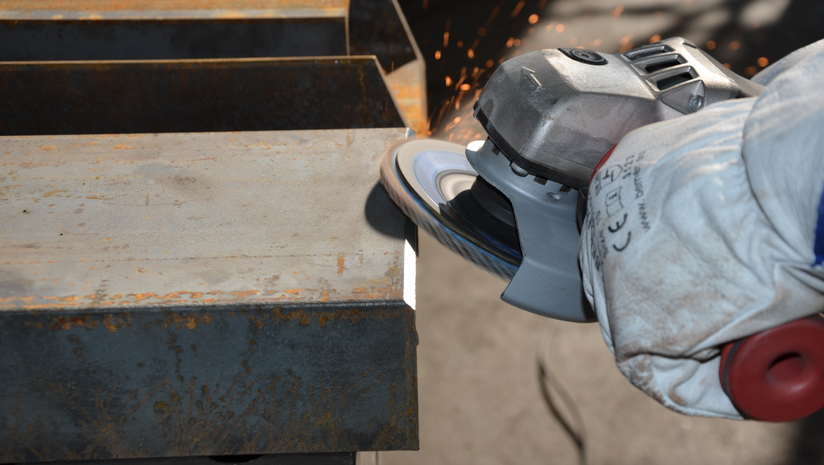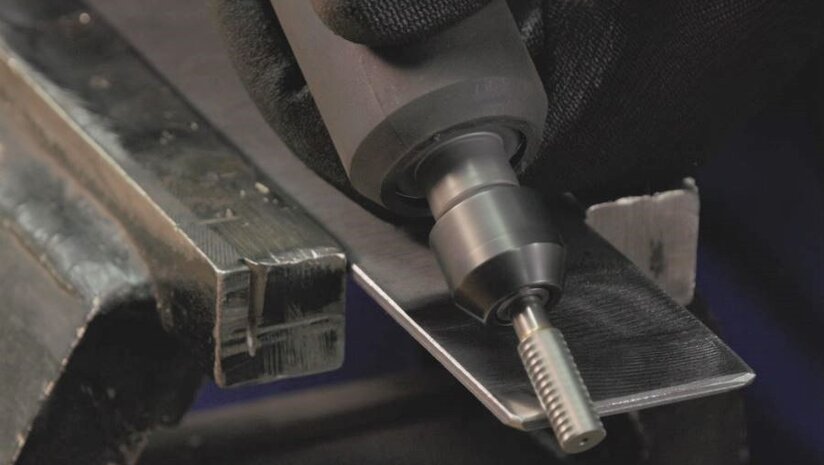
Beveling
If two workpieces are to be welded together, the edge of the workpieces must first be broken by a beveled surface. This is done by machining. The result is a chamfer, also known as a bevel.
What is beveling and
why is it important?
If two workpieces are to be welded together, the edge of the workpieces must first be broken by a beveled surface. This is done by machining. Or in other words, a space is created to accommodate the individual welding layers through which the workpieces are joined together. The bevel can have different shapes. The V-joint, the double V-joint, and the Y-joint are the most common shapes.
Which tool is used for beveling?
The position of the weld, the material of the workpiece, and the types of drives available - the choice of the right tool depends on various factors.
If an angle grinder is available, the beveling can be done with sulfur- and iron-free Osborn flap discs. Flap discs with a conical or straight shape are available. The angle on the workpiece determines the shape of the flap wheel.
If a workpiece made of non-ferrous metal is to be beveled, we recommend an abrasive cloth with a cooling bond as it reduces blue tarnish.

Pictured: Beveling with an Osborn flap disc.
If a straight grinder or air grinder is available, chamfering can be done with carbide burrs. The milling head is made of tungsten carbide-cobalt, the shank of tool steel. Different head shapes and toothings ensure that there is the right solution for every application.
For chamfering, burrs with cross serration (Z6) are the best choice. It ensures high stock removal in a short time. If the surface quality is important, a single tooth (Z3) is recommended. In the shipyard sector, the special shipyard toothing is often used. Compared to the Z6 toothing, it has a 30% higher material removal rate.

Camfering with a carbide burr.
Products for
Beveling.

FLR Flanged - Concentric Stud Style, Inch Sizes
Flanged Concentric Stud Style Cam followers are a type of cam follower bearings that have a flange on one side and a stud on the other side. The stud provides a way to attach the bearing to a shaft or other mechanism, while the flange helps to locate and stabilize the bearing. These cam followers are typically used in applications where a high load capacity is needed, and where the bearing needs to be attached to a shaft or other mechanism.

FLRE - Flanged Eccentric Stud Style - Inch Sizes
Flanged eccentric stud style cam followers are bearings that consist of a cylindrical outer ring with a flange on one end and an inner ring that is attached to the stud shaft by an eccentric collar. This design allows for adjustability of the radial clearance between the cam and the follower. The flange on the outer ring allows for easy installation and the stud shaft can be used for attaching other machine components.

FLRY Flanged Yoke Style - Inch Sizes
A Flanged Yoke Style Cam Follower is a type of roller bearing that has an outer flange or rim to increase the surface area and stability of the bearing. It is commonly used in high-load and high-misalignment applications, providing increased stability and accuracy for the cam or track it is following. The flange also helps to simplify the mounting process and provides additional support for the bearing.

FLRS Stainless Steel Concentric Stud Flanged Cam Followers - Inch Sizes
Stainless steel concentric stud flanged style cam followers are bearings that consist of a cylindrical outer ring with a flange on one end, a central concentric stud that allows for attaching other machine components and a inner ring that rotates around the stud axis. They are made of stainless steel which is highly resistant to corrosion and rust. This makes them suitable for use in harsh environments where corrosion resistance is required.

CLRY Crowned Yoke Style - Inch Sizes
A Crowned Yoke Style cam follower is a type of roller bearing with a convex (crowned) outer surface that helps to reduce stress and evenly distribute load across the bearing surface. It is commonly used in applications where heavy loads and high-misalignment conditions are present, and helps to ensure consistent contact between the bearing and the cam or track it is following.
HPC Plain - Concentric Stud Style - Metric Sizes
A Plain Concentric Stud Style Cam Follower is a type of roller bearing that has a cylindrical stud as the inner raceway, with the outer raceway being a cylinder that is concentric with the stud. This design provides a simple and reliable solution for light to medium load applications where a low profile and minimal axial space are required. The stud allows for easy installation, and the plain (non-flanged) outer surface provides minimal axial height, making it suitable for applications with tight installation constraints.

FLRC - Flanged Crown Style - Concentric Stud Style, Inch Sizes
Flanged crown concentric cam followers are a type of bearing that consist of a cylindrical outer ring with a flange on one end, and a cylindrical or crowned inner ring that rotates around a central axis. They are designed to follow the movement of a cam, which is a mechanical device that converts rotary motion into linear motion. The flange on the outer ring allows for easy installation, while the concentric design helps to maintain proper alignment and reduce wear on the bearing.

PLR Plain - Concentric Stud Style, Inch Sizes
A Plain Concentric Stud Style Cam Follower is a type of roller bearing that has a cylindrical stud as the inner raceway, with the outer raceway being a cylinder that is concentric with the stud. This design provides a simple and reliable solution for light to medium load applications where a low profile and minimal axial space are required. The stud allows for easy installation, and the plain (non-flanged) outer surface provides minimal axial height, making it suitable for applications with tight installation constraints.

PLRE Plain - Eccentric Stud Style, Inch Sizes
A Plain Eccentric Stud Style Cam Follower is a type of roller bearing that has a cylindrical stud as the inner raceway, with the outer raceway being a cylinder that is offset (eccentric) with the stud. This design provides a simple and reliable solution for light to medium load applications where the ability to compensate for misalignment or shaft deflection is required. The stud allows for easy installation, and the plain (non-flanged) outer surface provides minimal axial height, making it suitable for applications with tight installation constraints. The eccentricity of the outer raceway provides the ability to adjust for misalignment, making it suitable for use in applications with shaft deflection or other sources of misalignment.

HPCA Plain - Yoke Style - Metric Sizes
A Plain Yoke Style Cam Follower is a type of roller bearing that has a plain (non-flanged) outer surface and a yoke-shaped inner ring. It is commonly used in light to medium load applications and provides a simple, low-cost solution for cam and track following. The yoke-shaped inner ring allows for easy installation and the plain outer surface provides minimal axial height, making it suitable for applications with tight installation constraints.

HPCE Plain - Eccentric Stud Style - Metric Sizes
A Plain Eccentric Stud Style Cam Follower is a type of roller bearing that has a cylindrical stud as the inner raceway, with the outer raceway being a cylinder that is offset (eccentric) with the stud. This design provides a simple and reliable solution for light to medium load applications where the ability to compensate for misalignment or shaft deflection is required. The stud allows for easy installation, and the plain (non-flanged) outer surface provides minimal axial height, making it suitable for applications with tight installation constraints. The eccentricity of the outer raceway provides the ability to adjust for misalignment, making it suitable for use in applications with shaft deflection or other sources of misalignment.

PLRNE Nylon Tread Load Runners - Eccentric Stud Style
A Nylon Tread Eccentric Cam Follower is a type of roller bearing that has a cylindrical stud as the inner raceway and a nylon outer raceway that is offset (eccentric) with the stud. Nylon is a low-friction, wear-resistant material that is well-suited for use in light to medium load applications where corrosion resistance and low friction are important factors. The eccentric stud provides the ability to compensate for misalignment or shaft deflection, making it suitable for use in applications with these types of issues. The stud allows for easy installation and the plain (non-flanged) outer surface provides minimal axial height, making it suitable for applications with tight installation constraints